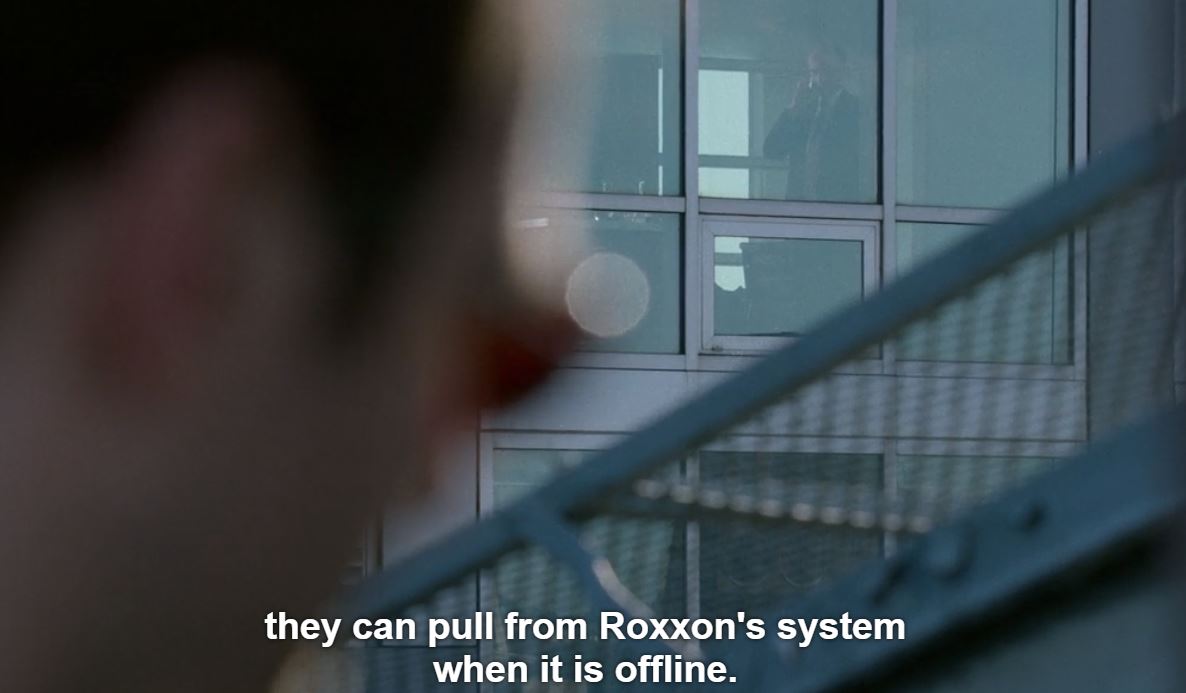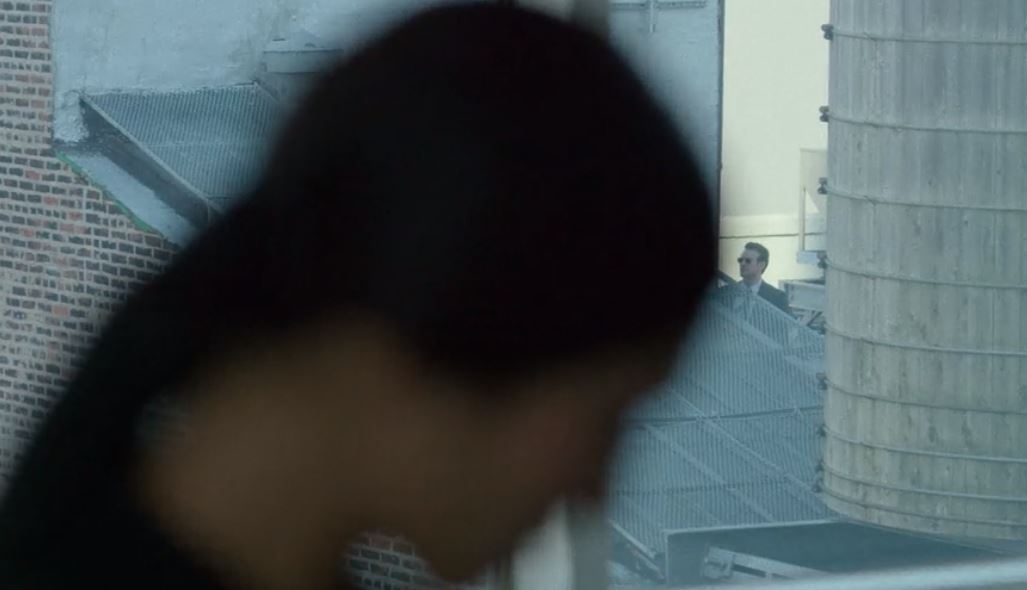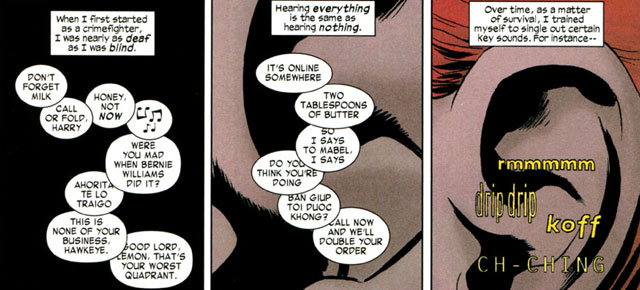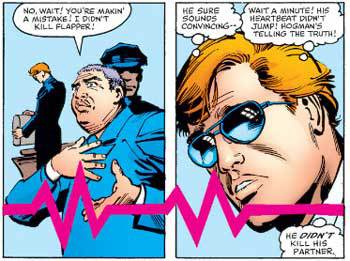There’s this thing Daredevil does with sound. Yeah, yeah – along with being able to hear really, really…really well.
He can focus in on one particular sound, blocking out all others. It’s been shown over the years in comics as he can “focus” on a specific sound (often a heartbeat) and follow it through a room or down a street. Naturally, whispered conversations many feet away on a bust New York City street ain’t no big thing for him to hear, either.
An example of Daredevil (secret identity, Matt Murdock) using this ability was shown in the episode 5, “Kinbaku,” of season 2 of the Netflix Daredevil series. In the scene, Elektra is having a meeting with Roxxon representatives in the Yakatomi Building and Murdock, trying to figure out what Elektra is up to, climbs to a rooftop adjacent to the Roxxon building, and is clearly shown “listening in” on the conversation taking place in the room. The room that’s in a modern high rise building that’s across the street. And as the scene shows and he indicates later in the episode, he hears the conversation.
Whoa.
So how “heightened” does his hearing must be to listen in? Very. Let’s get into the science of sound and Daredevil’s hearing.
First up, some facts about sound:
- Sound is energy. It’s just vibrations in a medium. When sound is produced, it pushes the particles of the medium. They bump into the next particles, and the original particle oscillates back. In air, the threshold of human hearing is when the molecules have a maximum displacement of 1 x 10-11 meters, while the threshold for pain corresponds to a maximum displacement of 1 x 10-5 m (the diameter of a molecule is about 1 x 10-5 m).The closer the particles are to one another, the quicker they can bump into one another and therefore, the faster sound moves in that medium. Sound moves the fastest through solids, next fastest through liquids, and the slowest through gas.And of course, no medium, no sound. In space, no one can hear you scream.
- Frequency is the measurement of waves per second, and is measured in Hertz (Hz). 100 Hz? 100 waves per second. 8.4 kilohertz? 8.4 x 1000 (“kilo”) = 8400 waves per second.
- Sound is created by something moving something (your vocal cords, a speaker cone, a drum head). Moving something requires a force being applied to that thing, and the rate at which that force is applied is what physics calls power. That’s measured in Watts. You want a loud car stereo? Get the one with the higher Watt output.
- Generally, sound moves away from is source in a sphere. The rate at which the energy of the sound flows through the sphere of expanding sound is called intensity, and it’s measured by dividing the Watts by the area of the sphere (I = W/m2).
- The relative intensity of a sound is called the intensity level, or the decibel level. Decibels are what we think of as volume. That’s an okay correlation.
- The volume of sound (measured in decibels) decreases proportionally to the square of the distance the receiver is from the source of the sound. Decibels are measured logarithmically, that means that for every ten decibel decrease, the volume is roughly cut half.
Got that?
So let’s get the scenario set up and see what we can figure out. Murdock climbs up to the rooftop of a building that’s about 130 feet away from the conference room in the Yakatomi Buidling, and roughly on the same level.
The camera shots and sounds make it clear that Murdock can hear the elevator in the hallway outside the conference room, as well as Elektra walking across the hallway and into the room. Inside the room, Elektra and the Roxxon executives are having a normal conversation, and again – we’re shown that Murdock can hear all of it, down the clicking of Elektra’s pen.
Let’s set up a model that represents the basics of this scenario before we start to complicate things. What I’d like to know is this: what could someone hear if they were 130 feet (40 meters) away from a normal conversation. How many decibels would get to that point from the origin of the sound?
Two quick assumptions: 1) The source of the sound (a person speaking) is going to be treated as a point source of sound, so as a result, the sound comes out as perfect sphere, and 2) The conversation between the Roxxon execs and Elektra was normal tones and not heated. A normal level for a conversation in a room such as the one shown is roughly 60 decibels (dB). That means that, Elektra, sitting about 2 meters away from a Roxxon exec is experiencing 60 dB. As always, your mileage may vary, and if it does, please do the problem with your own numbers. Small changes in measurement or dB won’t make gigantic changes in the final answer, but go for it anyway.
So our question is – stripping everything else (the windows, the room, putting them on a flat plain) away – what would Daredevil be hearing 40 meters away if Elektra was experiencing 60 dB?
This sounds like a super-simple problem, but when we dig into the physics, there’s some back and forth work that needs to be done.
We know the decibels that Elektra is experiencing and we want to know the decibels that Murdock is experiencing, 40 meters away from her. Since decibels are log-based, and sound emanates from the source as a sphere, this is going to get a little complicated. There’s no quick conversion or formula we can use. We could estimate – as a rule of thumb, every time you double the distance from the source, you lose about 6 dB – but let’s try to be a little more precise.
Our plan of attack:
- Figure out the intensity of the sound at Elektra’s position.
- From that, calculate the power of the sound source.
- From that, calculate the intensity of sound experienced by Murdock (there’s an easier alternate to this that we’ll hit, too).
- From that, calculate the decibels of sound that are reaching Murdock.
Step 1: Intensity of the sound.
If the sound is emanating as a sphere, that means that the energy is equal at all parts of the surface of that sphere. In others words, Elektra, sitting 2 meters from the speaker, is at the edge of a sphere that is receiving so many Watts per square meter.
To figure out the intensity at 2 meters, we need to go back to thinking about decibels as intensity level. Hey – there’s a formula for that:
β = 10 log (I/I0)
β = decibels
I = intensity that corresponds to the decibel value
I0 = the reference intensity, that is, the sound intensity at the threshold of human hearing(*). That value is 1.0 X 10-12 W/m2.
(*) Yes – I know Daredevil has way better than human hearing. Waaaaaay better. But we’re not worried about that here – we just want to know the decibel level at Murdock’s position, 40 meters away from Elektra.
Remember – we’re working on the intensity of the sound at Elektra’s position, so we’re using 60 dB.
Working out the formula, then:
60 = 10 log (I/1.0 X 10-12)
6.0 = log (I/1.0 X 10-12)
1.0 x 106 = I/1.0 X 10-12
I = 1.0 x 10-6 W/m2
Cool – that’s the intensity at 2 meters from the source.
Step 2: The power of the source
(This first part is totally an option – there’s an easier way around this and you don’t even have to calculate the power of the source, but I’m old school and like to see how all the pieces fit.)
Remember the definition of intensity of a wave’s energy? Power per area. We know the intensity, and we know the distance Elektra is from the source, and we know that the sound emanates as a sphere, so…
I = P/4πr2
That’s what I just said – power per area. The area we’re talking about is the surface of a sphere, so we use 4πr2, the formula for the surface of a sphere – r2 is the radius of the sphere. In our problem, that’s the distance between Elektra and the source of the sound.
Putting in the values and solving for P then…
1.0 x 10-6 = P/4π(2)2
1.0 x 10-6 = P/50.3
P = 5.03 x 10-5 W
That’s the power used by the speaker to produce a 60 dB sound at 2 meters. That value doesn’t change. It is what it is.
Step 3: What’s the intensity of the sound experienced at Murdock’s position?
By the way, Murdock’s position is 42 meters. He’s 40 m from Elektra who herself is 2 m from the source of the sound.
For this, we just use the last formula, but this time, use a new value for r and then solve for intensity. So…
I = P/4πr2
I = 5.03 x 10-5/4π(42)2
I = 5.03 x 10-5/22167
I = 2.3 x 10-9 W/m2
An (easier) alternative to this would be using the ratios of intensities and distances from the source of the sound:
I1/I2 = r22/r12
For this approach, just plug the values in (Murdock is I2 and r22) and you’ll get the same answer.
Step 4: What is the decibel level at Murdock’s position?
We know the intensity at Murdock’s location, so we just need to use our first formula:
β = 10 log (I/I0)
β = 10 log (2.3 x 10-9 /1.0 X 10-12)
β = 10 log(2300)
β = 34 dB
And that’s our answer. Taking everything away – the room, the building, and assuming ideal conditions in which sound can travel, a 60 dB conversation would have dropped to 34 dB 42 meters away from the source.
It’s not as dramatic as you hoped, huh?
Ah, but it is – remember, decibels are a logarithmic scale. The difference between 60 dB and 34 dB is not “just” 26 dB. Again, think of it this way – for every doubling if the initial radius (2 meters), you lose, on average, half the volume. 40 meters is roughly four doublings of the initial radius. At 40 meters away from the source, the sound is only 1/8th as loud for Murdock as it is for Elektra – and that’s with idea conditions.
Real world – if 60 dB is a normal conversation, 34 dB is a quiet rural night. A library. Hearing protection worn in industry looks to reduce the incoming sounds to around 30 dB if possible. 30 dB is about the volume of a whispered conversation.
And Daredevil hears it (and more) just fine. Like he’s in the room with them.
Okay – that’s the simple stuff. I simplified this problem a lot by taking away the building and the city. What happens to the sound reaching Daredevil when you add them back in?
Yeah – you’re probably thinking the right thing. It goes down in intensity and volume.
First off – the windows. The Yakatomi Building looks modern, so it’s a safe bet that the windows, given their size, are energy efficient. That means they’re (at least) double paned and probably laminated to keep the infrared (heat, mostly) and ultraviolet energy from passing through them from the outside and to keep the infrared from passing through them from the inside as well.
Double-paned windows are constructed so that the space between the two panes of glass is filled with a gas that will not (or will only very slowly) allow heat to pass through. Often times this gas is something heavy like sulfur hexafluoride. The laminate is a coating on the window itself which will block certain types of energy. All told, the idea is for the windows to keep the heat out in the summer and the heat inside during the winter.
What does this have to do with sound?
In New York, along a busy (noisy) street – you’d most likely want some sound proofing, so it’s a safe bet that the Yakatomi windows have some measure of absorbing the sound and not allowing it to attenuate. The sound proofing technology would be aimed at keeping the outside sounds out, but it would work with keeping the inside sounds in as well.
That 34 dB that’s reaching Murdock? That’s looking way optimistic. If we just say that the sound reaching him, due to the windows and other materials between him and the speakers drops 10 dB to 24 dB, then going by our rule above, the conversation sounds half as loud as it did at 34 dB. It’s gone from a whispered conversation to faintly rustling leaves. Under 20 dB, and normal humans have a very hard time hearing anything at all.
Also, as sound gets softer, we lose lower frequencies (bass notes and deeper voices). This would mean that even though the conversation still is reaching Murdock, he could lose the bass tones just due to the dB level.
Additionally, he was listening to the meeting during the day – on a busy New York City street. While sound levels vary widely in New York based on location, an average value for a street would fall around 70 dB, but can hit 90+ dB when a particularly noisy car or truck drives by. Every 10 decibels feels like the noise is twice as loud.
What does this mean for Daredevil?
He’s trying to listen to a conversation 40 meters away that, if fainter than the quietest whisper. To hear it, he must somehow block out the constant noise that is many, many times louder than his target conversation.
And hearing is just one of his senses that’s been amplified by the radioactive goo that splashed on his face when he was a kid. Turn them all up this high? He definitely needs a guide to teach him how to block some out while letting others in.
One final real-world tie-in. There is a medical condition where people have extremely sensitive hearing – too much, too loud, and no filter. Called hyperacusis, this is not a super power. Everything is too loud, from the quietest TV to a car horn to the potato chip you’re crunching on. Taking up the mantle of a crime fighter? Not really. People with hyperacusis are usually homebound, trying to find better and better sound cancelling headphones to allow themselves moment of quiet.
Of course, finally – by breaking this all down, we’re not looking to spoil Daredevil for anyone. Being able to hear something that quiet? That’s a superpower. Knowing how quiet that sound is? That just makes him cooler. And as always – maybe you learned a thing or two along the way.












